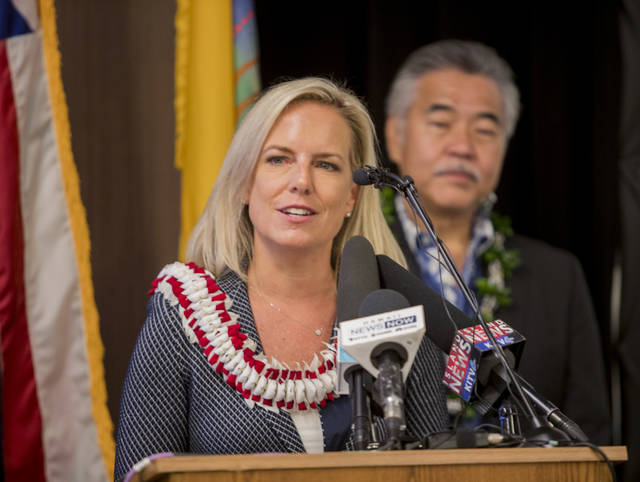Federal response to Hurricane Lane ‘just the beginning’


DENNIS ODA / DODA@STARADVERTISER.COM
Hawaii Governor David Ige (back) held a news conference with U.S Department of Homeland Security Secretary Kirstjen Nielsen (speaking) and Federal Emergency Management Agency Administrator Brock Long (not in picture) to discuss collaboration and response to Hurricane Lane, the Kilauea eruption and the April floods.


Secretary of Homeland Security Kirstjen Nielsen arrived in Hawaii on Thursday, one week after rain from Hurricane Lane began pounding Hawaii island, and said the federal government will continue to respond in the wake of the powerful storm.
“Our initial response is just the beginning. We remain here and will be here,” Nielsen declared during a news conference at the Hawaii Emergency Management Agency’s Joint Information Center in Diamond Head.
Nielsen, Gov. David Ige and Federal Emergency Management Agency Administrator Brock Long met with the press after Nielsen was briefed about ongoing recovery efforts following Hurricane Lane. She was also briefed on the Kilauea eruption and the record- breaking April flooding.
Unlike the mayor of San Juan, Puerto Rico, who on Wednesday blasted President Donald Trump and his administration for their response to last year’s Hurricane Maria, Ige was effusive in his praise for FEMA and the administration.
“I’ve never seen so many FEMA personnel in the state, in each and every county, to provide expertise, support, advice, allowing us to have access to resources, both knowledge as well as personnel (and) resources that we would not have had access to without their support,” Ige said.
Ige called FEMA “terrific partners” and “more than responsive” in answering the call to disaster in Hawaii since April.
Don't miss out on what's happening!
Stay in touch with breaking news, as it happens, conveniently in your email inbox. It's FREE!
“They’ve executed their mission tirelessly and with great compassion for the people of Hawaii. We are eternally grateful,” the governor said.
Nielsen, who stopped in Hawaii on Thursday after attending a ministerial meeting in Australia, said more than 3,900 FEMA and other federal workers were deployed to Hawaii or were already supporting the state prior to Lane’s arrival.
Among those deployed, she said, were three urban search-and-rescue support teams, two incident management assistance teams and mobile emergency response support personnel and equipment, which remain in place today.
Long told reporters that FEMA resources will continue to remain in Hawaii for at least a few more months.
“We’ve put a lot on the island as a result of Lane that we’re not going to take off,” he said. “We’re going to leave it here because you’re in the heart of the hurricane season.”
Long resisted comparing cleanup efforts in Puerto Rico with those in Hawaii, saying, “That’s apples and oranges.”
But he did say Hawaii’s infrastructure is much better maintained. He said he was impressed by Hawaiian Electric Co.’s robust mutual aid agreements with mainland utilities and its stockpiles of poles ready to replace any that get knocked down.
“A lot of thought from last year has gone into Hawaii, which I believe pre-positioned us very well for this event,” he said.
He said FEMA prepared the islands by acquiring more space to stockpile food, water and other commodities.
But because FEMA aid kicks in only after a disaster, legislation is needed to allow even more upfront efforts to shore up roads, electrical grids and infrastructure.
At the same time, there’s a need to better incorporate the private sector and the average citizen into the response, Long said.
“We gotta stop viewing citizens as survivors only,” he said.
Long said he hopes to develop a culture of preparedness in Hawaii.
“It’s been a long time since 1992,” he said, referring to Iniki, the Category 4 hurricane that battered Kauai with 145 mph winds and caused billions of dollars in damage.





